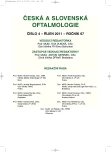Long Term Results of Laser Refractive Operations – Methods Epi-LASIK or LASEK
Authors:
V. Bernátová; S. Synek
Authors‘ workplace:
Refrakční centrum Kliniky nemocí očních a optometrie LF MU a Fakultní nemocnice u sv. Anny, Brno, prednosta doc. MUDr. Svatopluk Synek, CSc.
Published in:
Čes. a slov. Oftal., 67, 2011, No. 4, p. 119-128
Category:
Original Article
Overview
Purpose:
To compare and evaluate postoperative results of two methods of refractive laser surgery, Epi-LASIK and LASEK, performed at the Department of Ophthalmology and Optometry of St. Anne’s University Hospital Brno, Czech Republic.
Methods:
128 eyes operation were performed on patients with myopia, 102 with the Epi-LASIK method and 26 with the LASEK method. The preoperative mean spherical equivalent was -4.8 ± 2.6 D (range -2.3 to -7.5) in the Epi-LASIK eyes and -3.5 ± 3.1 D (range -1.6 to -7.8) in the LASEK eyes. The average preoperative uncorrected visual acuity (UCVA) was 0,129 (from 0.02 to 0.8) with the Epi-LASIK method and 0,246 (from 0.02 to 0.8) with the LASEK method. The best average corrected visual acuity was 1,139 (from 0.63 to 1.6) with the Epi-LASIK method and 1.115 (from 0.25 to 1.25) with the LASEK method. The average cylindrical refraction of the Epi-LASIK patients before the operation was -1.52 ± 0.80 D (range -1.0 to -3.5) and the LASEK patients was -1.55 ± 0.89 D (range -1.0 to -3.0), except of those who have astigmatism up to ± 0.75D. In both methods was used the excimer laser Mel 80 Meditec-Zeiss with 193 nm wavelength and the frequency of 250 Hz and active eye-tracking system.
Results:
The postoperative mean spherical equivalent was 0 ± 0.5 D (range -0.6 to 0.6) in the Epi-LASIK eyes and 0.3 ± 0.4 D (range -0.3 to 0.7) in the LASEK eyes. The average uncorrected visual acuity was 0.745 with Epi-LASIK and 0.687 with LASEK after first week, 0.996 and 1,083 after month, 1.068 and 1.063 after 3 months, 1.147 and 1,082 after 6 months, 1.090 and 1.031 after one year. The average cylindrical refraction after the operation was -0.82 ± 0.69 D (range 0 to -1.7) with Epi-LASIK and -0.59 ± 0.55 D (range 0 to -1.5) with LASEK. Average “haze“, evaluated by the Gartry’s scale, was 0.39 with Epi-LASIK and 0.46 with LASEK after week, 0.21 and 0.06 after one year.
Conclusions:
The Epi-LASIK and LASEK methods have comparable postoperative results of visual acuity, astigmatism, “haze“. They are effective too in worse form of the myopia.
Key words:
Epi-LASIK, LASEK, myopia
Sources
1. Hejcmanová, M., Horáčková M.: Vliv laserového refrakčního zákroku LASIK na zrakové funkce u myopie. Čes a slov Oftal, 62, 2006; 3: 206–217.
2. Loukotová, V., Vlková, E., Horáčková, M. Kontrastní citlivost a aberace vyšších řádú po konvenčním LASIKu. Čes a slov Oftal, 65, 2009; 5: 167–175.
3. Camellin, M., Wyler, D. Epi-LASIK versus epi-LASEK. J Refract Surg, 2008; Jan. 24(1): 57–63.
4. Hondur, A., Bilgihan, K., Hasanreisoglu, B. A prospective bilateral comparison of epi- LASIK and LASEK for myopia. J Refract Surg, 2008; Nov. 24(9): 928–934.
5. O’Doherty, M., Kirwan, C., O’Keeffe, M., O’Doherty, J. Postoperative pain following epi-LASIK, LASEK, and PRK for myopia. J Refract Surg. 2007; Feb. 23(2): 133–138.
6. Teus, MA., de Benito- Llopis, L., García-González, M. Comparison of visual results between laser-assisted subepithelial keratectomy and epipolis laser in situ keratomileusis to correct myopia and myopic astigmatism. Am J Ophthalmol, 2008; Sep. 146(3): 357–362.
7. Juhás, T. ml., Juhás, T., Horňák, M. EPI-LASIK- 2-ročné klinické skúsenosti. Čes a slov Oftal, 63, 2007, 4, 243-248.
8. Autrata, R., Řehůřek, J. Laser-assisted subepithelial keratectomy for myopia: two-year follow-up. J Cataract Refract Surg, 2003; 29, 4: 661–668.
Labels
OphthalmologyArticle was published in
Czech and Slovak Ophthalmology

2011 Issue 4
Most read in this issue
- Unilateral Cystoid Macular Edema Induced by Citalopram – a Case Report
- Morphologic Changes of Anterior Segment of the Eye after Cataract Surgery
- Long Term Results of Laser Refractive Operations – Methods Epi-LASIK or LASEK
- Retinitis Septica Roth – a Case Report
